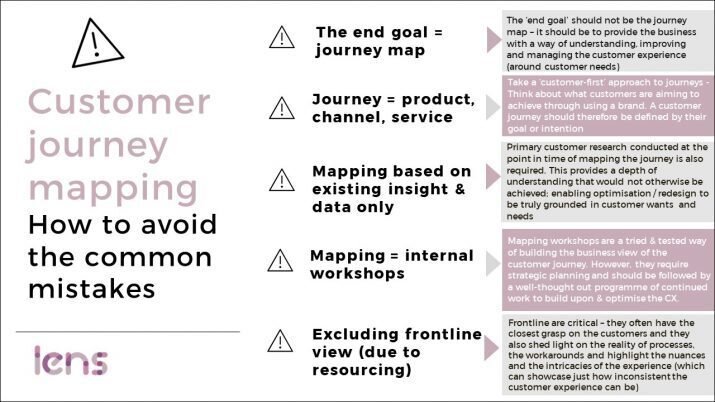Customer journey mapping: How to avoid the common mistakes…

1. The journey map as the ‘end goal’
The common mistake
- If the production of a journey map is the main aim, and hopes are on the map to ‘turn insight into action’, then this will lead to disappointment
- The map might as well be a report, or another way of presenting some information, perhaps just a bit prettier and more visually engaging
- In this instance, a journey map has no more guarantees of driving action than any other form of an insight-led report or document – a map isn’t magic
Avoiding the mistake…
- Customer journey mapping should be part of an overall commitment towards taking a customer-first approach
- Outputs such as the map and action plans are the tools that will support this – only then, will the map become magical
- The ‘end goal’ for mapping customer journeys should be to provide the business with a way of understanding, improving and managing the customer experience (around customer needs)
2. A customer journey defined by a product, channel or service
The common mistake
- We have witnessed many briefs over the years with requirements to map specific journeys such as the ‘contact centre’ journey, the ‘mortgage’ journey, the ‘personal advisor’ journey
- This approach is an ‘inside out’ view of the customer journey, whereby the journey is viewed from a business and operational perspective, rather than from how the customer would view their experience
- Taking this ‘inside out’ approach to mapping a journey would be a mistake and would result in not achieving the true benefits of a customer journey approach
Avoiding the mistake…
- Customer journey mapping requires an ‘outside in’ view to be taken from the offset; defining journeys according to what customers are able to / want to achieve with a brand
- Once a business has defined their journeys according to this, customer journey mapping will come in to its own, enabling a business to:
- Map the end-to-end journey - the start and end points of the journey from the customers’ point of view and all that happens in-between, and not just the interactions with the business itself
- Understand the role of channel(s), why customers use specific channels and when (by choice or being forced due to issues in other channels), how customers move between channels
- The needs and wants of customers across the journey, and the intended outcomes - how these differ and the extent to which a brand is delivering on this (according to different goals / intended outcomes) e.g. ‘Outside in’ view: ‘Mortgage journey’, ‘Inside out’ view: ‘I want to buy my first home’, ‘I want to remortgage my house’ etc.
- The true opportunities to optimise the journey through understanding the emotional and rational context (not just the physical interactions) and the aspects of the experience that a brand could potentially play a role / stronger role in (that they may not know exist or are viewed as ‘out of their control’)
3. Building a view of the customer journey through use of existing insight only
The common mistake
- Use of insight and data that is held internally across the business is critical – in both building an initial view of the journey and to continue to monitor performance of a business’ customer journeys
- Using this as the only source of insight, however, means that
- The business does not actually engage with customers as part of the process of mapping journeys, they don’t witness actual customer experiences and the true impact these are having
- The experiences may be ‘out of date’ - we have been through journey mapping exercises with clients ourselves and witnessed changes to internal processes that have been made internally by the business in-between the time we have mapped the ‘as is’ to the point in which we were optimising
- The detail gets missed – the detail that can reveal some pretty ginormous issues with the customer experience. A specific example we have come across is where routing of customers between channels appeared so much more complex than the business viewed it. This revealed that the no-one across the business was actually managing the process that enabled customers to successfully book an appointment in the channel of their choice.
- The emotional context gets lost – ‘People will forget what you said, people will forget what you did, but people will never forget how you made them feel’ – with emotion believed to account for 70% of the CX (McKinsey - “70% of buying experiences are based on how the customer feels they are being treated.”). Without this understanding of emotion, how will a business be able to delight customers and truly innovate around their needs?
Avoiding the mistake...
- Existing insight that is held across the business will be hugely valuable as part of building the view of the customer journey and measuring performance moving forwards. This should not, however, replace the need to conduct primary customer research with customers who are experiencing / have experienced the journey
- Every exercise that involves mapping journeys should involve direct engagement with customers, be it existing ones, lapsed and prospect – nothing will replace this! CUSTOMER journey mapping – the clue is in the name!
4. Customer journey mapping - another term for 'workshops'
The common mistake
- As a clientside professional once said to us.. "I’m sure you run a great workshop, just like every other consultant…"
- Thank you we thought (!), but running ‘another workshop’ is the least of our concerns – it’s the 2000 pain point post-it notes that you are now having to ‘address’…
- When establishing a clients’ starting point for customer journey work, we also sometimes hear… “We have mapped the journey already – we have run lots of workshops internally”
Avoiding the mistake…
- Mapping journeys in business / stakeholder workshops are a tried and tested way of mapping the customer journey from an internal perspective – and it’s great to see so many organisations doing this
- But to us, it’s not just a ‘workshop’, it’s a very strategically planned exercise, call it a workshop or not, it requires:
- a significant amount of planning and set-up, executed in the right way
- a very clear set of mapping guidelines and definitions – for mapping key components such as phases, stages, touchpoints, MoT’s etc.
- an ability to manage and facilitate differing perspectives without it resulting in a ‘battleground’
- an ability to consider all views without resulting in 2000 ‘pain points’
- facilitated action planning and continued engagement on the back of the workshops
- a well-thought out programme of continuous work and assigned responsibility that will make absolutely certain that the end result is not a journey map (in a drawer)
5. Frontline representation
The common mistake…
- Understandably, frontline representation across a programme to map, optimise and/ or redesign journeys can be a challenge – be it a global cabin crew or a UK based small contact centre team
- Due to resourcing challenges, clients often ask that we forego frontline representation as part of the mapping process
Avoiding the mistake…
- Frontline are critical – they often have the closest grasp on the customers and they also shed light on the reality of processes, the workarounds and highlight the nuances and the detail of the experience (which can showcase just how inconsistent the customer experience can be)
- Frontline employees are also the ones that will need to embrace any change so are the people you need to make feel involved from the offset and throughout for the whole exercise to pay off…
- Plan ahead and accommodate in any way you can to make sure the frontline view is in some way represented as part of the business view of the customer journey
These are just some of the easy mistakes to make…We’d love to hear about your own experiences of customer journey mapping and discuss how to overcome any challenges you might be facing or have faced.

